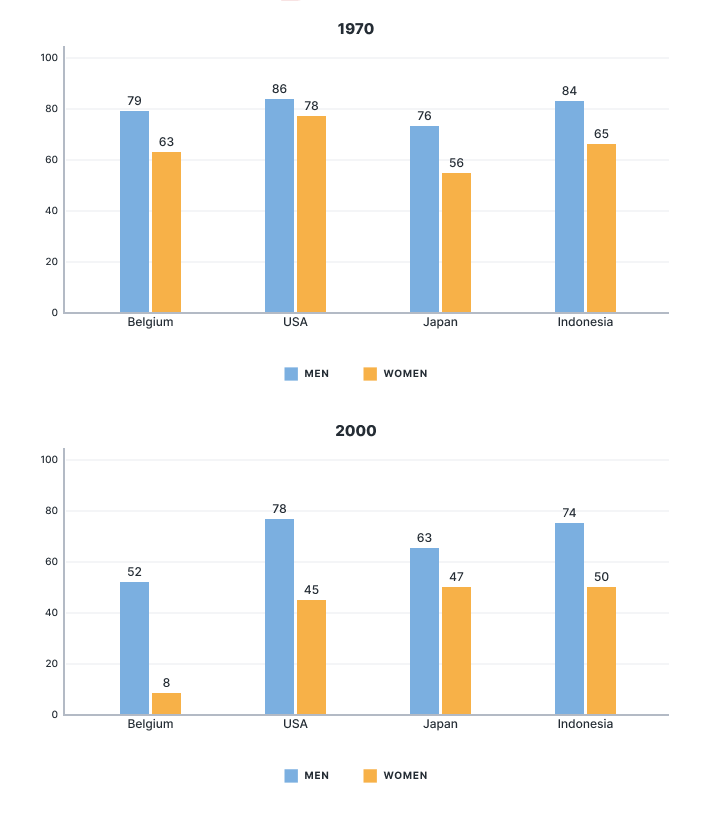Summarise the information by selecting and reporting the main features and make comparisons where relevant.

Bài mẫu
The bar chart depicts the employment rates of individuals aged 60 to 64, categorized by gender, in four different countries.
In general, there was a significant decrease in employment rates for both men and women across all four countries over a span of 30 years. Additionally, regardless of the country, the percentage of employed males in the 60-64 age group consistently exceeded that of females in both years.
Cách chia thân bài theo các quốc gia:
In 1970, 86% of men aged 60-64 in the USA were employed, which was the highest among the four countries and was a slight margin ahead of Indonesia’s male employment rate by a mere 2%. Similarly, the employment rate for women in the same age group was much higher in the former than in the latter, at 78% and 65% respectively. By 2000, there was a decline of 8% and 10% in employment rates for males in the USA and Indonesia respectively. Mirroring the same trend, albeit much more pronounced, female employment rates fell to 45% and 50% respectively.
Initially, Japan ranked fourth in employment of this age cohort, with 76% for males compared to 56% for females, but both figures went down to 63% and 47%, concluding at the third position. Belgium had 79% of males and 63% of females aged 60-64 employed in 1970, higher than Japan’s; however, thereafter, 52% of males at that age still worked while a minority of senior women in this nation were employed (8%), both of which were lowest among these nations.
Cách chia thân bài theo thời gian:
In 1970, the male employment rates did not present significant discrepancies, with 86% of men in the United States aged 60-64 being employed, closely followed by 84% in Indonesia, 78% in Belgium and 76% of Japanese males. Female job participation repeated the same pattern. To specify, 78% of American women in this cohort still secured employment, which was highest, while the lowest female employment rate was recorded in Japan (56%). Belgium and Indonesia had relatively similar proportions for 60-64-year-old employed females, at 63% and 65%.
After three decades, employment rates of 60- to 64-year-old people in all nations experienced a decline. While three out of the four countries, namely the USA, Japan, and Indonesia, recorded similar decreases of around 10% for males, to 78%, 63% and 74% respectively, the figures for their female counterparts fell by 33%, 9%, and 15%, respectively. Employees in Belgium aged 60-64 presented the most noticeable change, with proportions decreasing by 27% for males and 55% for females.
[stu alias=”khoa_truy_cap_cac_bai_giai_de”]Từ vựng tốt trong bài
- Exceed (v): vượt quá
Giải thích: to be greater than a number or amount, or to go past an allowed limit
Ví dụ: The success of our campaign has exceeded our wildest expectations.
- Ahead of : trước
Giải thích: in front of someone or something
Ví dụ: She finished the race ahead of all her competitors.
- Respectively (adv): theo thứ tự
Giải thích: in a way that relates or belongs to each of the separate people or things you have just mentioned
Ví dụ: In the 200 metres, Lizzy and Sarah came first and third respectively (= Lizzy won the race and Sarah was third).
- Mirror the same trend (v): phản ánh xu hướng tương tự
Giải thích: to imitate the same pattern or direction.
Ví dụ: The sales of the new product were mirroring the same trend as its predecessor.
- Albeit (adv): mặc dù
Giải thích: although
Ví dụ: She decided to go on the trip, albeit she was feeling a bit unwell.
- Age cohort (n): nhóm tuổi
Giải thích: a group of individuals who are of similar age.
Ví dụ: The study analyzed the spending habits of different age cohorts in the population.
- Thereafter (adv): sau đó
Giải thích: continuing on from a particular point in time, especially after something else has stopped happening
Ví dụ: He left the priesthood in 1970 and settled in the Washington area shortly thereafter (= soon after that).
- Discrepancy (n): sự khác nhau
Giải thích: a difference between two things that should be the same
Ví dụ: here is some discrepancy between the two accounts.
- Repeat the same pattern (v): lặp lại xu hướng tương tự
Giải thích: to replicate or reproduce an identical pattern.
Ví dụ: The artist decided to repeat the same pattern across the entire canvas to create a sense of unity in the painting.
Lược dịch tiếng Việt
Biểu đồ cột mô tả tỷ lệ việc làm của những người ở độ tuổi 60 đến 64, được phân loại theo giới tính, ở bốn quốc gia khác nhau.
Nhìn chung, tỷ lệ việc làm ở cả nam và nữ đã giảm đáng kể ở cả bốn quốc gia trong khoảng thời gian 30 năm. Ngoài ra, bất kể ở quốc gia nào, tỷ lệ nam giới có việc làm trong độ tuổi 60-64 luôn cao hơn nữ giới trong cả hai năm.
Cách chia thân bài theo các nước:
Năm 1970, 86% nam giới ở Mỹ trong độ tuổi 60-64 đã có việc làm, đứng đầu trong bốn quốc gia và chỉ cao hơn tỷ lệ việc làm của nam giới ở Indonesia đúng 2%. Tương tự, tỷ lệ việc làm cho phụ nữ cùng độ tuổi ở Mỹ cao hơn so với Indonesia, lần lượt là 78% và 65%. Đến năm 2000, tỷ lệ việc làm giảm đi 8% và 10% cho nam giới ở Mỹ và Indonesia. Phản ánh xu hướng tương tự, mặc dù rõ rệt hơn nhiều, tỷ lệ việc làm của nữ giảm lần lượt xuống 45% và 50%.
Ban đầu, Nhật Bản xếp thứ tư về việc làm trong nhóm tuổi này, với 76% cho nam giới so với 56% cho phụ nữ, nhưng cả hai con số đều giảm xuống còn 63% và 47%, kết thúc ở vị trí thứ ba. Bỉ có 79% nam giới và 63% nữ giới trong độ tuổi 60-64 làm việc vào năm 1970, cao hơn Nhật Bản; tuy nhiên, sau đó, 52% nam giới ở độ tuổi đó vẫn đi làm trong khi thiểu số phụ nữ cấp cao ở quốc gia này đã có việc làm (8%), cả hai đều thấp nhất trong số các quốc gia này.
Cách chia thân bài theo thời gian:
Năm 1970, tỷ lệ nam giới có việc làm không có sự khác biệt đáng kể, với 86% nam giới ở Hoa Kỳ trong độ tuổi 60-64 được tuyển dụng, theo sát là 84% ở Indonesia, 78% ở Bỉ và 76% nam giới Nhật Bản. Sự tham gia công việc của phụ nữ lặp lại mô hình tương tự. Cụ thể, 78% phụ nữ Mỹ trong nhóm này vẫn có việc làm, cao nhất, trong khi tỷ lệ nữ có việc làm thấp nhất được ghi nhận ở Nhật Bản (56%). Bỉ và Indonesia có tỷ lệ tương đối giống nhau đối với nữ giới có việc làm ở độ tuổi 60-64, lần lượt là 63% và 65%.
Sau ba thập kỷ, tỷ lệ việc làm của người từ 60 đến 64 tuổi ở tất cả các quốc gia đều giảm. Trong khi ba trong số bốn quốc gia là Mỹ, Nhật Bản và Indonesia ghi nhận mức giảm tương tự khoảng 10% đối với nam giới, xuống còn 78%, 63% và 74%, thì con số này đối với nữ giới lại giảm 33%, 9 % và 15% tương ứng. Người lao động ở Bỉ trong độ tuổi 60-64 có sự thay đổi rõ rệt nhất, với tỷ lệ giảm 27% đối với nam và 55% đối với nữ.
[/stu]











